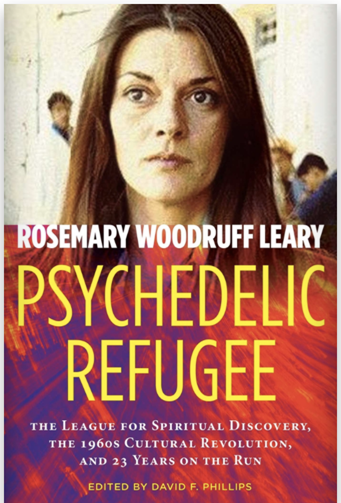
Her decision to participate in a jailbreak was arguably the biggest of Rosemary’s life. No matter what the outcome, there would be severe repercussions that would affect the rest of her life. If the plot failed, Tim would probably be moved to Folsom or San Quentin where he would remain for many years and the prison authorities would probably uncover her participation in the plot. If the jailbreak succeeded, Rosemary would be deemed a high-profile criminal for “aiding and abetting” his escape. She would be aggressively pursued by the FBI and the Bureau of Narcotics and Dangerous Drugs (BNDD). Rosemary was on parole from previous charges, so her participation was very risky to say the least. Despite the serious consequences, Rosemary embraced the plot even though she was not convinced that it would succeed.
Psychedelic Refugee emphasizes that Rosemary’s optimism seemed to stem from her experiences with psychedelics. It is hard to explain or quantify, but experimenting with psychedelics makes certain people bolder than they normally would be. Through her experiments with altering her consciousness, Rosemary had learned to embrace a state of fearlessness. The jailbreak plot was yet another test of her will power and inner strength.
“Through her experiments with altering her consciousness, Rosemary had learned to embrace a state of fearlessness.”
Rosemary was a key player in the escape plot. She raised $20,000 from the Brotherhood of Eternal Love, an entity that was often generous with whatever financial resources they possessed. Rosemary also acted as a go-between with the Weather Underground who provided a getaway car, false identifications, and several safehouses in San Francisco, and Washington State. The plot itself contained multiple risks. The 49-year-old ex-psychology professor who smoked too much would have to climb a large tree and then scutter across a roof of two cell blocks to reach a telephone cable that he would have to grab with hand-ball gloves and carefully wrap his ankles around it; once all of his weight was resting on the telephone cable, he would then have to inch along it like a caterpillar until he reached the other side of the twelve-foot barbed-wire fence. If at any point he fell from the telephone wire, he would certainly break many bones and probably be Folsom-bound for probably the rest of his life. He would definitely lose his right to remain at California Men’s Colony in San Luis Obispo, the most “humane” prison in the state.
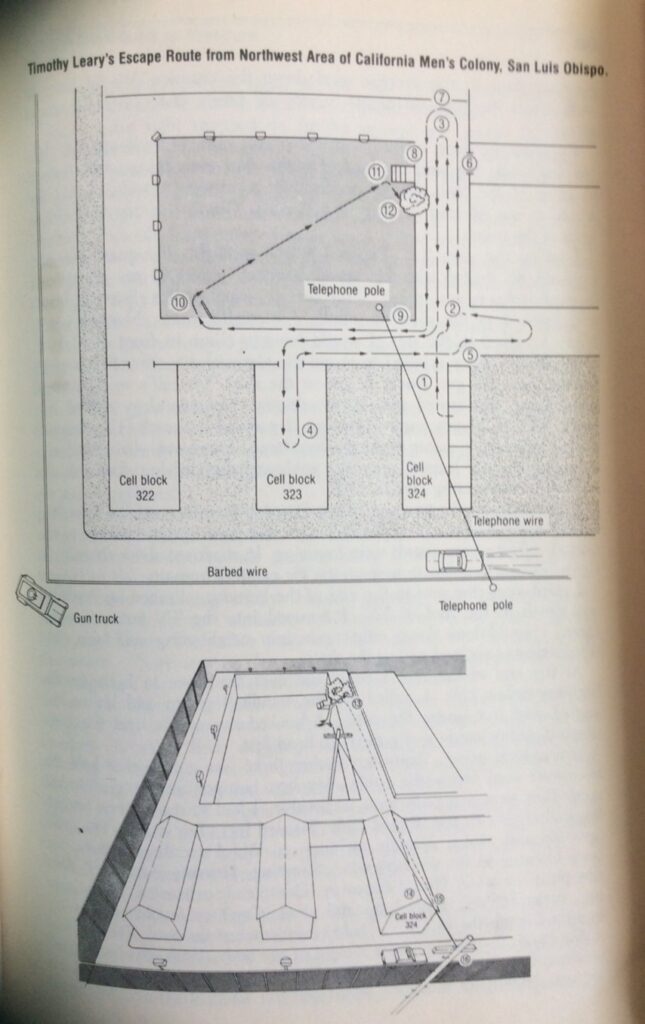
When the night of the jailbreak finally arrived, Leary did one last tarot card reading—we are not sure what the cards suggested—and then some yoga in the prison yard. As he settles his pose, the psychology professor focuses on the telephone pole and the telephone cable that he can see in the distance. He then visualizes himself crossing to the other side of the barbed-wire fence. Later that night he would successfully execute this escape plan and be whisked away to Washington State where he would finally be reunited with Rosemary.
Breaking Tim out of prison was certainly a bold gesture, but ironically it resulted in a state of unfreedom because both constantly worried about being apprehended by the FBI and the BNDD. Tim and Rosemary altered their appearances in order to escape detection. Leary became “William J. McNellis,” a midwestern businessman and Rosemary became “Margaret Ann McCreedy.”
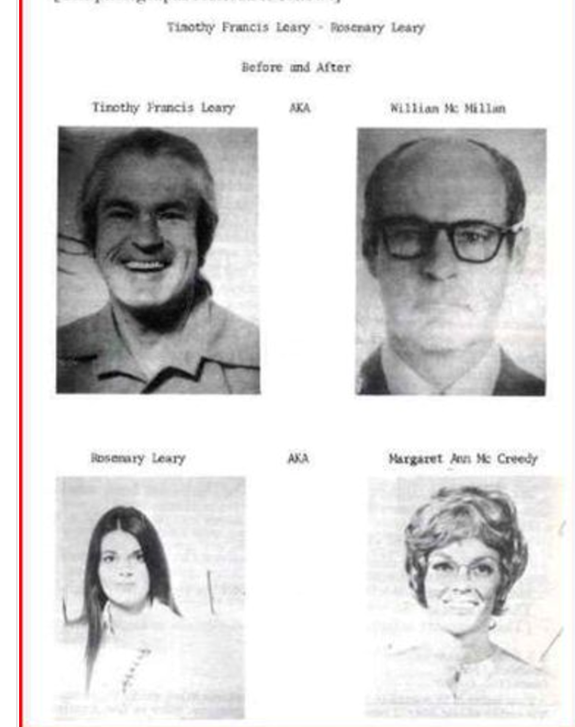
Their altered identities replaced the alteration of consciousness. However, Rosemary’s quest for autonomy extended into her personal life. In exile, Rosemary became increasingly depressed and alienated; it was difficult to live out a suitcase and the mounting pressure of increased surveillance weighed on her psyche and on her marriage. When the FBI, the BNDD, and the Nixon administration made Tim and Rosemary prime targets for capture, Rosemary struggled to maintain her sanity.
The post-jailbreak section of Psychedelic Refugee (1971 to the 1980s) focuses on Rosemary’s quest for inner peace and personal autonomy. As Rosemary is pulled further and further into Leary’s orbit, she found herself slowly losing her sense of individuality.
“It was as if he thrived on the response of the press, the need for more lawyers and funds, the threat of trial and prison, the invitation to climb onto the cross, the myth of the tragic hero: a sweet dream of oppression. It was [Timothy Leary’s] movie.”
Rosemary Woodruff Leary
The theme of losing her sense of self had been observed during earlier parts of her memoir. As early as 1966, Rosemary had also witnessed Tim’s curious response to the Millbrook bust: “Tim was released on bail later in the day. Unscathed, good-humored, and unworried, he seemed almost to enjoy this new confrontation with the law. It was as if he thrived on the response of the press, the need for more lawyers and funds, the threat of trial and prison, the invitation to climb onto the cross, the myth of the tragic hero: a sweet dream of oppression. It was his movie.”
Rosemary’s marriage to Leary gave her an intimate view of her husband’s fondness for self-mythologizing and the fact that he never met a microphone that he didn’t fall in love with. Although Tim seemed to relish playing archetypal roles for the counterculture—wise man, high priest, and anti-establishment rebel—Rosemary, while in exile, longs for a peaceful life and where she and Tim can write books and escape from the sycophants and the publicity machine that Tim cannot resist.
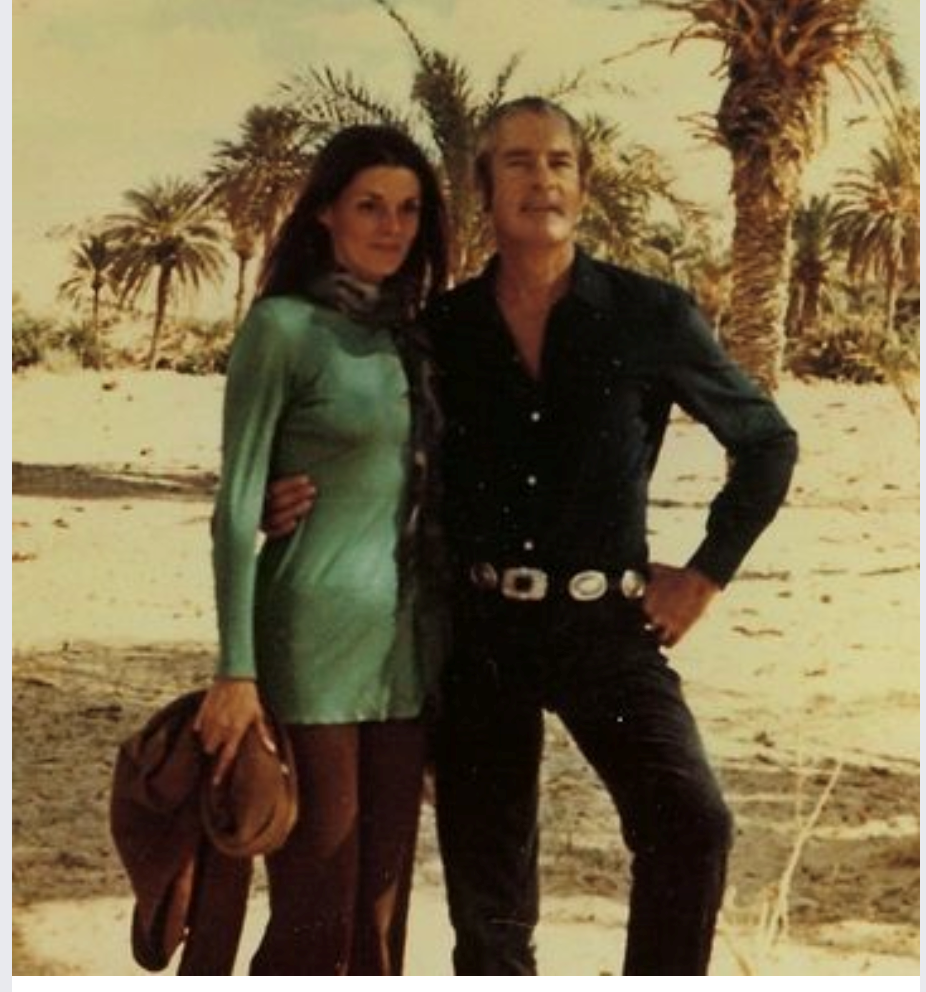
By the spring of 1971, Rosemary begins to seriously consider breaking away from Tim. At first, she sought a separation, but it became a permanent rupture. Rosemary’s account of their relationship in Psychedelic Refugee offers a more nuanced view of their marital politics. Rosemary was determined not to be a passive victim. Although Rosemary feared that she would be demonized by some in the counterculture for leaving her husband, she proceeded anyway.

Recordings are now available to watch here.
“Wandering and Return,” the final chapter, is perhaps the most fascinating of all; it covers Rosemary’s odyssey in the underground of the 1970s and her Homeric return to the United States in 1976. The narrative of this chapter is based on an interview she gave to Robert Greenfield in 1997. Rosemary spoke openly about her experiences in exile and was less concerned about incriminating herself and others. Here she mentions John Schewel, her handsome lover and companion in exile, for the first time. Rosemary describes how Schewel successfully ushered her into the underground when she left Leary in the fall of 1971. For two decades, Schewel and Rosemary traveled the globe, living in Canada, Afghanistan, Sicily, Colombia, and Costa Rica, completely under the radar of federal US authorities.
“I learned how to be myself and how to live without a man, how to cook for myself, and how to be alone.”
Rosemary Leary Woodruff
Rosemary and Schewel eventually reenter the US by posing as water skiers on a cigarette boat that safely comes ashore in Ft. Lauderdale, Florida. The couple eventually decided to settle in Provincetown, Massachusetts, which turns out to be a safe haven for Rosemary for nearly two decades. Although she enjoys living on the edge of Cape Cod, she reminds the reader that she always slept with her suitcase packed and her tennis shoes next to her bed. When she and Schewel go their separate ways in the 1980s, she embraces her new-found independence: “I learned how to be myself and how to live without a man, how to cook for myself, and how to be alone.”
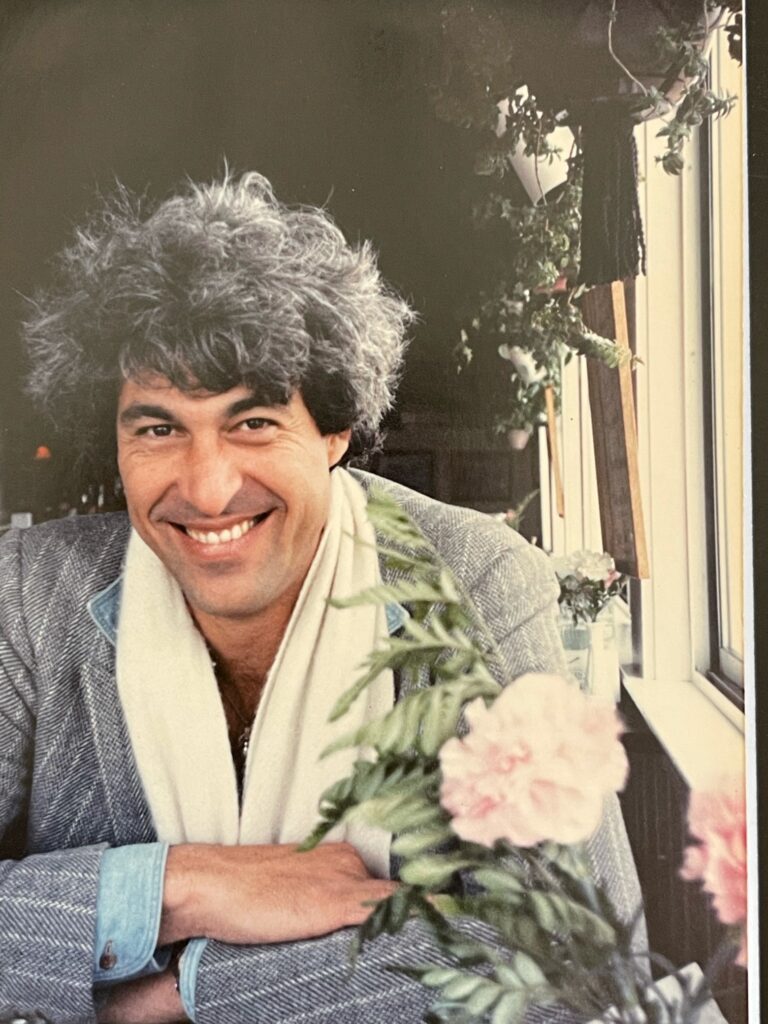
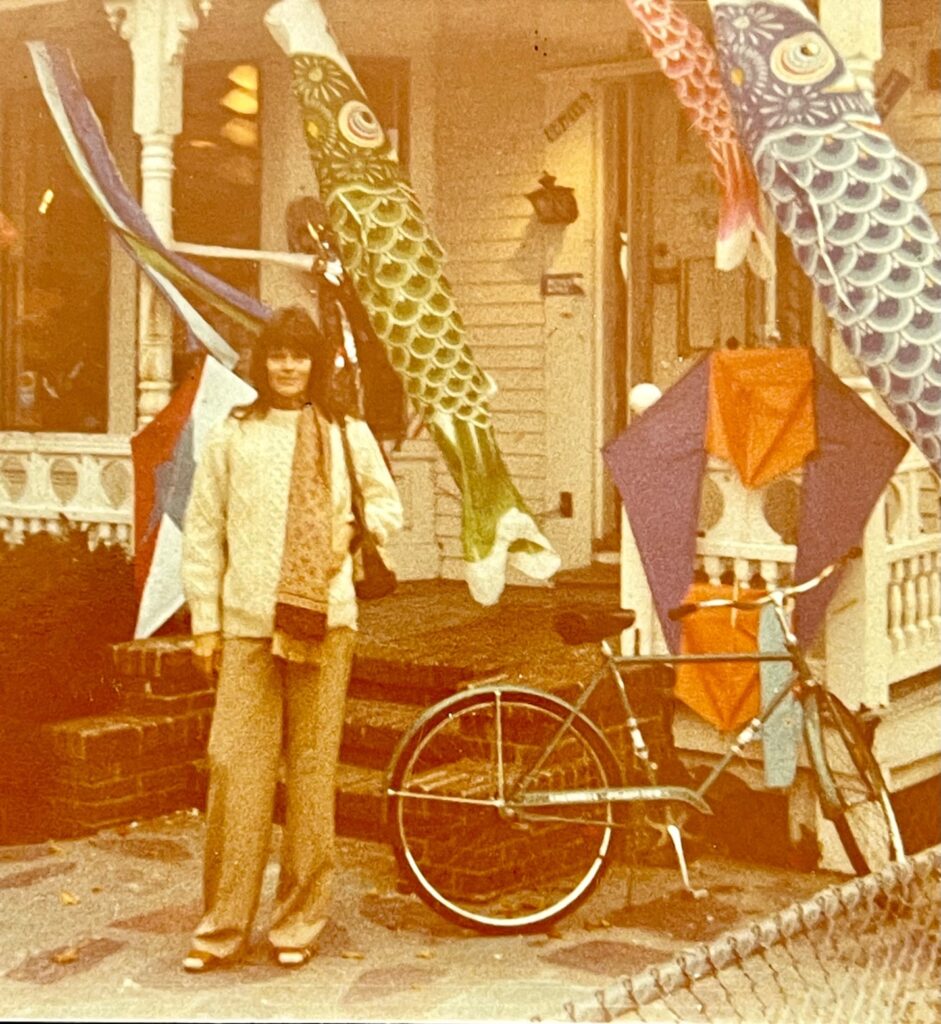
Psychedelic Refugee symbolically ends with Rosemary’s reunion with Tim some 20 years after their breakup in Switzerland. At this point, Rosemary was living underground and Tim was single after Barbara Chase, his fifth wife, had left him a few weeks earlier. Rosemary describes meeting at the Asian Art Museum in Golden Gate Park in December 1992: “Both of us were so physically altered as to be unrecognizable as who we had once been. But as always when we got together after an escape or when he had gotten out of jail, it was a movie. In Vista Vision and Technicolor. Wide Screen. Tim was so good at creating drama and he so loved to play and he was brilliant at it.” Tim even had ace up his sleeve: “He asked me to marry him [and] I said no. And he said, ‘Well then, I will have to cross you off my list’.”

Please donate to the Psychedelic Renaissance Documentary
After reading Psychedelic Refugee, I get the impression that there are many versions of Rosemary Woodruff Leary that circulate in the public imagination. For some, she was the svelte and beautiful wife of Timothy Leary who often appeared at his side during interviews for the press; for others, she is a fashion icon whose influence was recently lauded in Vogue magazine. For the psychedelic community and the counterculture, she is a heroic figure in the War on Drugs who stuck to her principles and steadfastly refused to name names to federal authorities. Each of these versions of Rosemary are accurate, but for me what stuck out the most in Psychedelic Refugee was the author’s robust sense of humor and her generosity of spirit in the face of adversity. After all, she had every right to be upset about the enormous sacrifices that she had to make during the last three decades of her life. Who would have thought that the vibrant and fun-loving narrator—a person who clearly loved life and being in the company of others—would end up living a solitary and Kafkaesque life in the underground for 23 years? Although Rosemary frequently found herself in precarious and absurd situations during her last three decades, Psychedelic Refugee is not the memoir of a bitter and angry person. Instead, it features the voice of a magnanimous heroine who lived long enough to tell her story.
Part One of “The Wonderful and Absurd Life of Rosemary Woodruff Leary: Fashion Icon, Fugitive, and Psychedelic Pioneer” can be found here:
Many thanks to John Schewel, Denis Berry, Gary Woodruff, and Lindsay Brice. I interviewed each of them so that I could understand more about the last ten years of Rosemary’s life. Although I didn’t actually use any citations from their interviews for this piece, I learned a great deal about Rosemary’s life and her decision to resurface in 1994. I also want to thank Thomas Lannon, the former curator of the New York Public Library’s Archives and Manuscripts Division. When I visited the New York Public Library in August of 2019, Thomas made sure that I had full access to Rosemary’s papers and The Magician’s Daughter manuscript. Lastly, I would like to thank the late David E. Philips, Rosemary’s friend and confidante, for rescuing Rosemary’s memoir from archival obscurity.
Discover the Indigenous Reciprocity Initiative of the Americas
Take a minute to browse our stock:
Did you enjoy reading this article?
Please support Chacruna's work by donating to us. We are an independent organization and we offer free education and advocacy for psychedelic plant medicines. We are a team of dedicated volunteers!
Can you help Chacruna advance cultural understanding around these substances?











